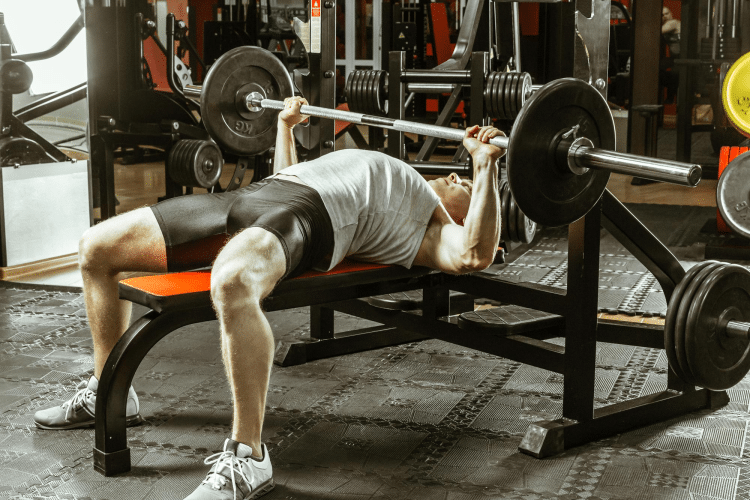The average untrained male can lift around 50 kilograms (40–70) in the squat and bench press and 90 kilograms (70–120) in deadlifts. The actual number can vary based on factors like age, body weight, fitness levels, and training experience.
A study published in Medicine & Science in Sports & Exercise emphasized the effectiveness of the bench press, deadlift, and squat in enhancing overall strength and performance, providing evidence of their positive impact on physical fitness. (1)
In this article, we’ll delve into the average squat, bench press, and deadlift numbers, learn how to set realistic goals, navigate training principles, and explore common misconceptions about setting new personal bests.
How Much Weight Can the Average Man Lift, Including Bench Press, Deadlift, and Squat?
How much weight can the average man lift?
It’s a question that sparks curiosity in gym newbies and seasoned lifters alike.
But the answer, my friends, is far from a simple number.
Level Up Your Fitness: Join our 💪 strong community in Fitness Volt Newsletter. Get daily inspiration, expert-backed workouts, nutrition tips, the latest in strength sports, and the support you need to reach your goals. Subscribe for free!
It’s an intricate dance between individual potential, training experience, and a host of other factors.
So, grab your metaphorical magnifying glass because we’re about to dissect the fascinating world of lifting benchmarks for the average man.
Bench Press: How Much Weight Can the Average Man Lift

Let’s start with the king of upper body exercises, the bench press.
Imagine a spectrum with untrained beginners on one end and seasoned powerlifters on the other. Where does the “average man” fall on this spectrum?
According to Symmetric Strength, a site dedicated to tracking lifting performance across genders, ages, and experience levels, here is the average bench press of males of different ages: (2)
| Age | Beginner | Novice | Intermediate | Advanced | Elite |
| 15 | 88 | 131 | 185 | 248 | 317 |
| 20 | 101 | 150 | 211 | 284 | 363 |
| 25 | 103 | 154 | 217 | 291 | 372 |
| 30 | 103 | 154 | 217 | 291 | 372 |
| 35 | 103 | 154 | 217 | 291 | 372 |
| 40 | 103 | 154 | 217 | 291 | 372 |
| 45 | 98 | 146 | 206 | 276 | 353 |
| 50 | 92 | 137 | 193 | 259 | 331 |
| 55 | 85 | 127 | 179 | 240 | 306 |
| 60 | 78 | 115 | 163 | 219 | 280 |
| 65 | 70 | 104 | 147 | 198 | 253 |
| 70 | 63 | 94 | 132 | 177 | 227 |
| 75 | 56 | 84 | 118 | 159 | 203 |
| 80 | 50 | 75 | 106 | 142 | 181 |
| 85 | 45 | 67 | 95 | 127 | 163 |
| 90 | 41 | 60 | 85 | 115 | 146 |
Average Bench Press Figures:
- Beginners (18-24 years old): 95-135 pounds (43-61 kilograms)
- Intermediate (25-34 years old): 135-185 pounds (61-84 kilograms)
- Advanced (35+ years old): 185-225 pounds (84-102 kilograms)
Remember: These are just averages, and individual numbers can vary greatly. Don’t get discouraged if you’re outside these ranges; progress is what matters.
Strength Standards:
Now, let’s introduce some established programs that set the bar for bench press prowess:
- Starting Strength: This beginner-friendly powerlifting program aims for a 1.5-times bodyweight bench press within six months.
- StrongLifts 5×5: Another beginner favorite, with a goal of reaching a bodyweight bench press within 12 weeks.
Factors Affecting Your Bench:
But wait, there’s more! Your bench press isn’t just about raw strength. Consider these factors:
- Technique: Master the form; a wobbly bench won’t yield impressive numbers.
- Grip Width: Narrower grips target the triceps, while wider ones focus on the chest.
- Equipment: An arched back can boost your press, while dumbbells offer a different challenge.
One of my clients was struggling with his bench press after a plateau. I analyzed his form, identified a slight shoulder imbalance, and adjusted his grip.
The result? A newfound 20-pound PR and a smile wider than his bench.
Read more: Average Bench Press By Age, Weight, Gender, and Experience Level
Deadlift: How Much Weight Can the Average Man Lift

Now, let’s shift gears to the deadlift, a compound exercise that engages your entire posterior chain. Buckle up because we’re about to lift some serious weight (metaphorically, of course).
| Age | Beginner | Novice | Intermediate | Advanced | Elite |
| 15 | 147 | 209 | 286 | 375 | 470 |
| 20 | 169 | 240 | 327 | 429 | 538 |
| 25 | 173 | 246 | 336 | 440 | 552 |
| 30 | 173 | 246 | 336 | 440 | 552 |
| 35 | 173 | 246 | 336 | 440 | 552 |
| 40 | 173 | 246 | 336 | 440 | 552 |
| 45 | 164 | 233 | 319 | 417 | 524 |
| 50 | 154 | 219 | 299 | 392 | 492 |
| 55 | 142 | 202 | 277 | 362 | 455 |
| 60 | 130 | 185 | 252 | 331 | 415 |
| 65 | 118 | 167 | 228 | 299 | 375 |
| 70 | 105 | 150 | 205 | 268 | 336 |
| 75 | 94 | 134 | 183 | 240 | 301 |
| 80 | 84 | 120 | 164 | 214 | 269 |
| 85 | 76 | 107 | 147 | 192 | 241 |
Average Deadlift Figures:
- Beginners (18-24 years old): 135-185 pounds (61-84 kilograms)
- Intermediate (25-34 years old): 185-245 pounds (84-111 kilograms)
- Advanced (35+ years old): 245-315 pounds (111-143 kilograms)
Factors Affecting Your Deadlift:
Deadlifts aren’t just about brute force. Here are some key factors that can affect your performance:
- Form: Keep your back straight, core engaged, and hips low for a safe and powerful lift.
- Stance Width: Narrower stances target quads. Wider ones engage the glutes more.
- Grip Types: Conventional (overhand) or mixed grip (one overhand, one underhand) each have their advantages.
I have my beginner clients focus on building core strength and perfecting their form before going for big weights.
The result? They not only smash their weight goal but also gained newfound confidence in their overall strength.
Read more: Average Deadlift By Weight, Gender, and Experience Level
Squat: How Much Weight Can the Average Man Lift

Finally, let’s squat our way to the bottom of this article. The squat, king of lower body exercises, builds leg strength, core stability, and overall athleticism.
| Age | Beginner | Novice | Intermediate | Advanced | Elite |
| 15 | 120 | 175 | 244 | 324 | 411 |
| 20 | 138 | 201 | 279 | 371 | 471 |
| 25 | 141 | 206 | 287 | 381 | 483 |
| 30 | 141 | 206 | 287 | 381 | 483 |
| 35 | 141 | 206 | 287 | 381 | 483 |
| 40 | 141 | 206 | 287 | 381 | 483 |
| 45 | 134 | 195 | 272 | 361 | 458 |
| 50 | 126 | 183 | 255 | 339 | 430 |
| 55 | 116 | 170 | 236 | 314 | 398 |
| 60 | 106 | 155 | 216 | 286 | 363 |
| 65 | 96 | 140 | 195 | 259 | 328 |
| 70 | 86 | 126 | 175 | 232 | 294 |
| 75 | 77 | 112 | 156 | 208 | 263 |
| 80 | 69 | 100 | 140 | 186 | 235 |
| 85 | 62 | 90 | 125 | 166 | 211 |
Average Figures:
- Beginners (18-24 years old): 135-185 pounds (61-84 kilograms)
- Intermediate (25-34 years old): 185-245 pounds (84-111 kilograms)
- Advanced (35+ years old): 245-315 pounds (111-143 kilograms)
Strength Standards:
The squat boasts impressive benchmarks across various programs and disciplines:
- Starting Strength: This beginner-friendly program aims for a bodyweight squat within six months.
- Westside Barbell Conjugate System: The conjugate training program utilizes various squat variations to push strength boundaries, often exceeding bodyweight by multiples.
Factors Affecting Your Squat:
While raw strength plays a part, mastering the squat hinges on more than just brute force. Consider these key factors:
- Form Variations: Low bar squats emphasize quads, while high bar squats target glutes and hamstrings. Choose the variation that suits your anatomy and goals.
- Depth Variations: Parallel squats reach a depth where your thighs are parallel to the ground, while ATG (Ass To Grass) squats go even lower. Explore your mobility and flexibility to determine your optimal depth.
- Equipment Choices: Barbells are among the most versatile and recruit core stabilizers, while machines offer stability and the option to lift heavier weights. Experiment to find what works best for you.
I once trained a client with a history of knee pain that hindered his squat progress.
We focused on improving his mobility, strengthening his core, and choosing a pain-free squat variation (high bar in his case).
Not only did it help lower the pain, but it also allowed him to establish a new squat personal best, his confidence soaring alongside the bar.
Remember, the quest to answer “How much weight can the average man lift?” is less about a single number and more about a personal journey of discovery.
By understanding the nuances of each lift, embracing individual differences, and focusing on proper form and consistent training, you can unlock your true strength potential, one rep at a time.
Read more: Average Squat By Weight, Gender, and Experience Level
The Allure of How Much Weight The Average Man Can Lift
Ever since Arnold Schwarzenegger hoisted trophies above his head, the allure of superhuman strength has captivated imaginations.
The question, “How much weight can the average man lift?” echoes in gyms, locker rooms, and even casual conversations.
Defining “average” in the fitness realm is like trying to nail down a cloud.
Age, training experience, genetics, and lifestyle all sculpt individual abilities.
A 20-year-old athlete and a 50-year-old weekend warrior will have vastly different baselines.
But fear not, for this exploration isn’t about rigid averages; it’s about understanding potential and charting your own path to strength.
Deconstructing the “Average”: Factors Influencing How Much Weight The Average Man Can Lift
Alright, folks, let’s ditch the “average man” myth and delve into the real nitty-gritty of lifting potential.
As a veteran personal trainer (and seven years crafting words that move iron!), I’m here to bust open the black box of strength and explore the true factors that make you, YOU, a lifting machine (or maybe a work in progress, but hey, everyone starts somewhere!).
Level Up Your Fitness: Join our 💪 strong community in Fitness Volt Newsletter. Get daily inspiration, expert-backed workouts, nutrition tips, the latest in strength sports, and the support you need to reach your goals. Subscribe for free!
So, grab your protein shake and settle in because we’re about to dissect the science behind how much weight the average man can lift, but remember, average is just a starting point, not a finish line.
1. Genetics & Body Composition
Imagine your body as a construction site. Your genes are the architect, laying the foundation for your muscular potential. Here’s the crew:
- Muscle Fiber Types: These are your workers, coming in two main forms: fast-twitch (explosive power) and slow-twitch (endurance). The ratio you inherit plays a role, but fret not, even fiber distribution can be optimized with training.
- Limb Length: Longer limbs offer a greater range of motion, potentially translating to heavier lifts (think long levers!). But don’t despair; shorter limbs often pack more power per inch, making them masters of technique and focused force.
Now, don’t forget the raw materials:
- Bodyweight: Heavier individuals generally have more muscle mass, offering a potential strength advantage. However, remember, muscle quality matters more than quantity. A leaner physique with efficient muscle recruitment can outperform bulk without proper training.
2. Training Experience & Technique
Here’s how your training journey shapes your strength:
- Training History: A seasoned lifter who’s been progressively overloading their muscles (adding weight or reps gradually) will undoubtedly lift more than a newbie. Consistency and dedication are key to unlocking your true potential.
- Proper Form: Lifting like a boss isn’t just about showing off (although, let’s be honest, it feels pretty good). The correct form protects you from injury and ensures your muscles are working optimally, maximizing strength gains. Think of it as using the right tool for the job.
3. Age & Fitness Level
Strength isn’t linear, friends. It’s a journey with peaks and valleys:
- Age: Testosterone, a key strength hormone, naturally declines with age. But fear not; strategic training and a healthy lifestyle can mitigate this decline and keep you lifting strong well into your golden years. Think of it like fine wine, getting better with age (and the right care).
- Fitness Level: Beginners experience rapid strength gains as their muscles adapt to new stimuli. Intermediates keep progressing with dedication and strategic programming. Advanced lifters push the boundaries, requiring meticulous planning and advanced techniques. Each level has its own challenges and triumphs.
4. Lifestyle & Nutrition
You wouldn’t put gasoline in a diesel engine, right? The same goes for your body. Here’s how your lifestyle choices impact your lifting potential:
- Sleep: When you sleep, your body repairs and rebuilds muscle tissue. Skimp on sleep and your strength gains suffer. Think of it as giving your muscles the rest they need to build bigger and stronger.
- Diet: You are what you eat! A balanced diet rich in protein, healthy fats, and complex carbohydrates provides the building blocks and energy your muscles need to thrive. Think of it as feeding your inner beast the right fuel for optimal performance.
- Recovery: Lifting breaks down muscle tissue, but rest and recovery strengthen it. Don’t neglect rest days and active recovery strategies like stretching and foam rolling. Think of it as giving your muscles the TLC they deserve to come back even better.
Remember, how much weight the average man can lift is just a starting point.
You are an individual — a unique blend of genetics, training, and lifestyle choices.
By understanding these factors and making informed decisions, you can unlock your true lifting potential and become the strongest version of yourself.
Now, go forth and conquer those weights!
Beyond the Numbers: Individualized Strength Potential and Setting Realistic Goals
Okay, let’s ditch the one-size-fits-all mentality and delve into the real magic: unlocking your own strength potential.
Forget chasing “averages” — they’re a blurry photograph in the fitness world. You are a unique specimen, and your journey will be too.
So, buckle up, aspiring Hercules, because we’re about to craft a roadmap that leads straight to achievable, personalized strength gains.
Remember, “How much weight can the average man lift?” doesn’t factor in your age, training experience, genetics, body composition, or even that time you accidentally lifted your car to avoid a rogue squirrel (true story, bro).
Here’s how we navigate beyond the noise:
1. Ditch the Averages, Embrace the Individual:
Imagine two people: John, a 22-year-old gym newbie, and Mark, a seasoned 45-year-old lifter. Comparing their starting points is like comparing apples to barbells.
Focus on your own progress, not some mythical “average.” Track your lifts, celebrate milestones, and be your own benchmark.
2. Setting Realistic Goals: Aim High, But Keep Your Feet on the Ground:
Dreaming of a 400-pound deadlift? Fantastic!
But if you’re currently struggling with the bar, that goal might be demotivating and unsustainable.
Instead, set SMART goals: specific, measurable, achievable, relevant, and time-bound.
Start with smaller wins, like adding 5 pounds to your bench press each week. As you progress, adjust your goals, always challenging yourself without setting yourself up for discouragement.
3. Train Like a Pro (Even if You’re Not One Yet):
Consistency is king. Aim for at least 2-3 strength training sessions per week, focusing on compound exercises that work multiple muscle groups.
Master proper form — it’s the foundation for safe and effective lifting.
Don’t be afraid to seek guidance from a certified personal trainer, especially if you’re new to the gym. They’ll help you design a program tailored to your goals and limitations.
4. Rest and Recovery: Your Muscles’ Secret Weapon:
Think muscles grow during your workout? Nope!
It’s during rest and recovery that your body rebuilds and strengthens.
Prioritize quality sleep, listen to your body’s rest signals, and don’t neglect active recovery strategies like stretching and foam rolling.
Remember, rest isn’t laziness; it’s fuel for your next PR.
So, how much weight can you lift? That’s the beauty — it’s up to you to discover.
By embracing your individuality, setting smart goals, training smart, and respecting your body’s need for rest, you’ll unlock a strength potential that goes far beyond any average.
Now go forth and conquer, one rep at a time!
Key Takeaways:
- Strength isn’t a monolith. It manifests in diverse forms, from the explosive power of a deadlift to the herculean endurance of a long-distance run. Discover your strengths and cultivate them with relish.
- Progress, not perfection, is the compass. Don’t be intimidated by the seemingly superhuman feats you witness online. Focus on consistent effort, proper form, and celebrating each incremental milestone.
- Seek guidance, not shortcuts. A qualified trainer can be your North Star, navigating you through the maze of information overload and crafting a personalized plan to unlock your potential.
- Listen to your body. It’s your invaluable partner, whispering wisdom through aches and radiating joy with triumphs. Respect its limits, honor its needs, and forge a harmonious connection.
Conclusion
So, how much weight can the average man lift? The answer, dear reader, is far more intricate than a single number.
It’s a tapestry woven from individual physiology, training experience, and unwavering determination.
While studies offer glimpses into population averages, your potential remains a unique and thrilling narrative waiting to be penned.
Remember, the path to strength is an exhilarating adventure, not a solitary trek.
Surround yourself with supportive communities, celebrate each other’s victories, and together, rewrite the narrative of what the “average man” can achieve.
The barbell awaits. What are you waiting for?
If you have any questions about how much weight can the average man lift, drop them in the comments below, and I’ll be happy to help!
References
- Latella, C., Owen, P. J., Davies, T., Spathis, J., Mallard, A., & VAN DEN Hoek, D. (2022). Long-Term Adaptations in the Squat, Bench Press, and Deadlift: Assessing Strength Gain in Powerlifting Athletes. Medicine and science in sports and exercise, 54(5), 841–850. https://doi.org/10.1249/MSS.0000000000002858
- Symmetric Strength. https://symmetricstrength.com/. Accessed January 30, 2024.











